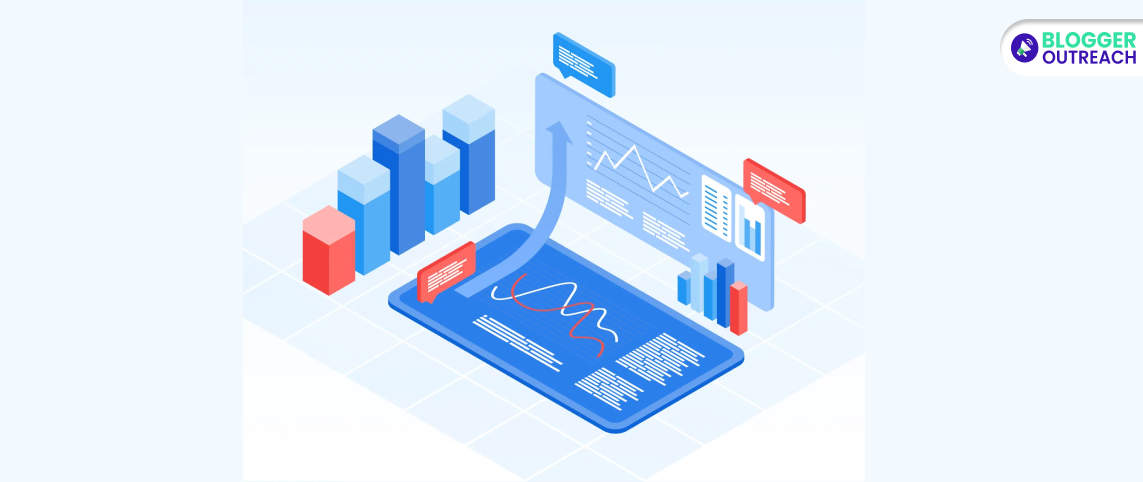Picture this…
You invest time, effort, and resources into crafting compelling digital campaigns…
…however, you are not getting the result you want.
Is your content driving the desired engagement?
Have you got your coveted ranking?
Are your ads resonating with your target audience?
These questions often haunt digital marketers.
It’s not just about the quantity of data; it’s about extracting meaningful insights to take your marketing in the right direction.
Enter digital marketing analytics.
This comprehensive guide will walk you through digital marketing analytics from A to Z. We will cover everything you need to know about analytics metrics, from the fundamental concepts to the intricacies.
Here, You Will Learn About:
- Digital marketing analytics.
- Benefits of digital marketing analytics.
- Important digital marketing analytics.
- How to make the most out of digital marketing analytics.
Table Of Content
What Is Digital Marketing Analytics?
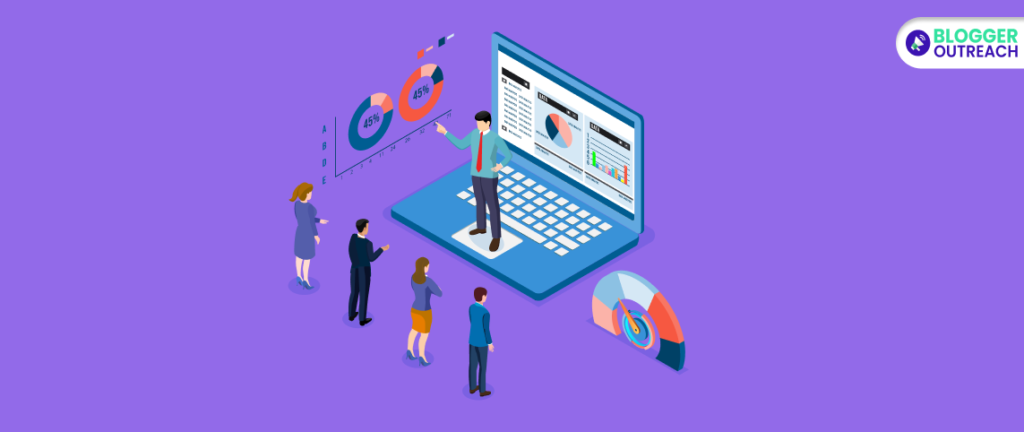
Digital marketing analytics is the compass guiding your online efforts. Data monitoring will empower you to understand what resonates and what requires adjustment in your efforts.
You can dive deep into metrics such as clicks, conversions, and user behaviour patterns through digital marketing analytics.
This comprehensive approach ensures you’re not merely navigating the digital landscape blindly but with a compass calibrated to your unique goals.
Adaptability relies on real-time data. Continuous analysis ensures you stay afloat and optimize for peak performance continuously.
In the ever-changing world of online marketing, digital marketing analytics is not just a tool; it is your ship’s lighthouse.
Imagine you run an online store selling handmade jewellery. Through digital marketing analytics, you discover that your website traffic spikes every Sunday evening. Digging deeper, you find that this coincides with increased engagement on your Instagram posts during that time.
10 Amazing Benefits Of Digital Marketing Analytics
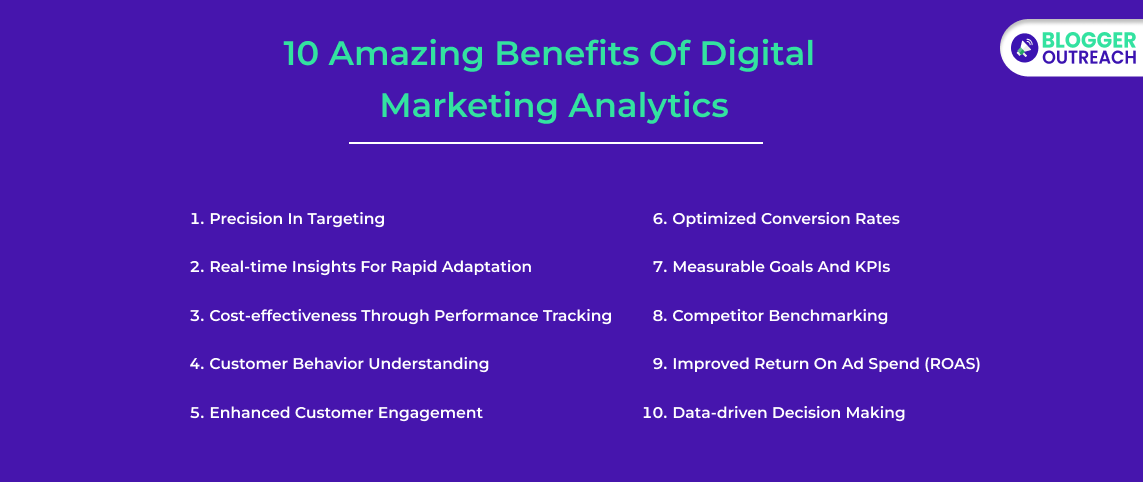
Nowadays, digital marketing analytics are a necessity, not an option.
Get to know the benefits of incorporating digital marketing analytics into your strategy.
1. Precision In Targeting
With digital marketing analytics, you can bid farewell to the era of casting a wide net and hoping for the best.
Instead, you can precisely target your audience based on demographics, interests, and behaviours. This means you reach the right people at the right time, increasing the likelihood of engagement.
2. Real-time Insights For Rapid Adaptation
Gone are the days of waiting for quarterly reports to gauge the success of your marketing efforts.
Digital marketing analytics provides real-time insights, empowering you to adapt and refine your strategy on the fly. This agility is crucial in the ever-evolving landscape of the digital sphere.
3. Cost-effectiveness Through Performance Tracking
Every penny spent on marketing counts, and digital marketing analytics allows you to track the performance of your campaigns meticulously.
By identifying what works and what doesn’t, you can allocate your budget more effectively, maximizing each marketing endeavour’s return on investment (ROI).
4. Customer Behavior Understanding
Understanding your customers is the key to any successful marketing campaign. Digital marketing analytics provides a treasure trove of data on customer behaviour, preferences, and journeys.
This insight allows you to tailor your approach, providing your audience a personalized and enriching experience.
5. Enhanced Customer Engagement
Engagement is the lifeblood of digital marketing, and analytics can be your guiding light. You can decipher what resonates most by analyzing customer interactions with your content.
This knowledge enables you to create content that captivates your audience, fostering a deeper and more meaningful connection.
6. Optimized Conversion Rates
Digital marketing analytics lets you scrutinize the customer journey, pinpointing areas where potential leads may drop off.
Armed with this information, you can optimize your conversion funnel, addressing pain points and streamlining the path from prospect to customer.
7. Measurable Goals And KPIs
Setting goals is essential, but measuring progress is equally crucial. Digital marketing analytics lets you establish key performance indicators (KPIs) and track progress. This transparency keeps your team focused and provides tangible evidence of your marketing efforts’ impact.
8. Competitor Benchmarking
Staying ahead in the digital landscape requires understanding where you stand compared to your competitors. Digital marketing analytics allows you to benchmark your performance against industry standards, helping you identify areas for improvement and innovation.
9. Improved Return On Ad Spend (ROAS)
Every advertisement should contribute to your bottom line. Digital marketing analytics lets you assess the return on ad spend (ROAS) with precision. By analyzing which channels and campaigns yield the best results, you can optimize your ad spend for maximum impact.
10. Data-driven Decision Making
Bid farewell to gut feelings and intuition-based decisions. Digital marketing analytics empowers you to make data-driven decisions, reducing the risk of errors and enhancing the effectiveness of your overall strategy.
Important Digital Marketing Metrics You Need To Know
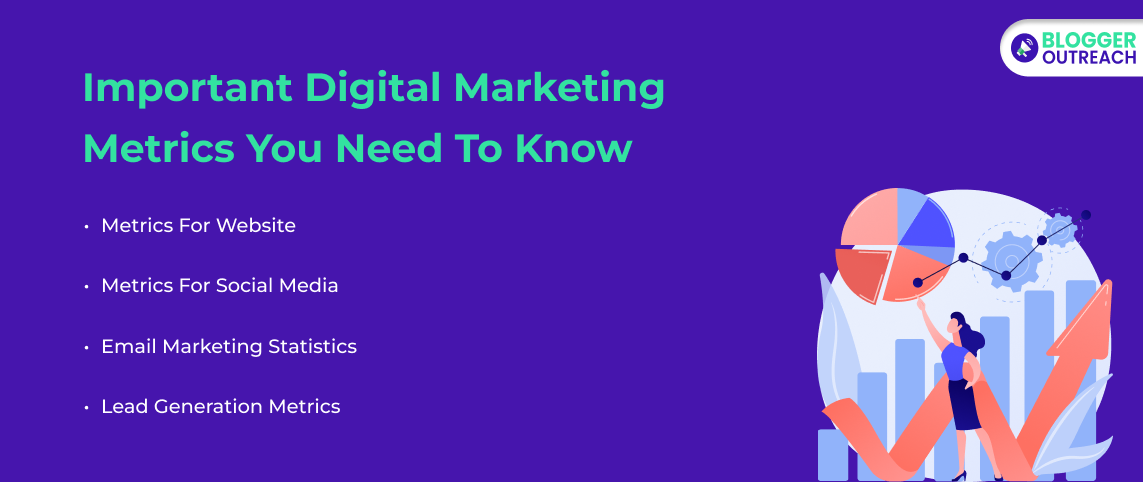
Digital marketing analytics is nothing without metrics. It’s like evaluating a website’s popularity without knowing the traffic.
Metrics For Website
(i) The Number Of Website Visits
It’s a simple yet powerful metric that quantifies the interest your content generates. Tracking this metric over time provides insights into the effectiveness of your overall digital presence.
(ii) Time Spent On Site
The time spent on site metric delves into the engagement level of your audience. The longer visitors stay, the more likely they are to convert or explore additional content.
Example: A five-minute average time spent on your site suggests that visitors find value and engage deeply with your content.
(iii) Pages Viewed
Beyond the initial landing page, the number of pages viewed provides a holistic view of user interaction. A high page view count indicates visitors navigating through your site and exploring various offerings.
Example: If a user reads a blog post, then clicks on related articles and browses your product pages, it’s a positive sign of engagement.
(iv) Returning Visitors
Monitoring the percentage of returning visitors helps gauge the loyalty and interest of your audience.
Example: A returning visitor rate of 30% implies a strong connection, showcasing that your content is resonating over time.
(v) Bounce Rate
A high bounce rate indicates that visitors are leaving your site after viewing only one page, possibly without taking any action.
Example: A 70% bounce rate may signal that your landing page needs optimization or that the content doesn’t align with visitor expectations.
(vi) Average Page Views
This metric provides a snapshot of how deeply visitors explore your site during a single session.
(vii) New Visits
The influx of new visitors is crucial for expanding your audience. Tracking the percentage of first-time visitors sheds light on the effectiveness of your marketing efforts in reaching new audiences.
(viii) Referral Sources
Understanding where your traffic comes from is vital. Referral sources encompass avenues like search engines, external links, and email campaigns that drive users to your site.
Metrics For Social Media
(i) The Number Of Followers
The number of followers reflects the size and reach of your social media community.
Example: Gaining 1,000 new followers after a targeted campaign indicates a successful expansion of your social media presence.
(ii) Number Of Engagements
Likes, comments, and shares are the lifeblood of social media. This metric quantifies the resonance of your content within your social media community.
(iii) Reach
Reach measures the unique users who see your content. It goes beyond engagements, providing insights into the overall visibility of your social media campaign.
Example: If your post reaches 10,000 users, it means your content has successfully penetrated a significant audience.
(iv) Impressions
While each focuses on unique users, impressions measure the total number of times your content is loaded, even if by the same user multiple times.
Example: A post with 20,000 impressions indicates a broad exposure, even if fewer unique users contributed to those impressions.
(v) Click-Through Rate
The click-through rate measures the percentage of people who see your content and take the next step by clicking on a link.
Example: The click-through rate of 5% indicates that 5 out of 100 viewers took action, which indicates good content.
(vi) Cost Per Action
Budgets matter, and so does the cost associated with each desired action. Calculating the cost per action helps evaluate the efficiency of your social media campaign.
Example: If a campaign costs $1,000 and results in 50 conversions, the cost per action is $20, clearly understanding the campaign’s financial efficiency.
Email Marketing Statistics
(i) Open Rate
The open rate measures the percentage of emails opened out of the total sent, indicating the effectiveness of your subject line and snippet content.
An open rate of 25% means that a quarter of your audience found your email intriguing.
(ii) Click-Through Rate
Beyond opening, clicking indicates a deeper level of engagement. The click-through rate measures the percentage of people who clicked on a link or button in your email.
Example: A click-through rate of 8% means that 8 out of every 100 email recipients engaged further by clicking, showcasing content relevance.
(iii) Unsubscribe Rate
While expanding your reach, it’s essential to monitor the unsubscribe rate. This metric tracks the number of people who opted out of your mailing list after receiving your email.
Example: A low unsubscribe rate of 1% suggests that your email content aligns with the expectations of your audience.
(iv) Email Bounce Rate
When a bounce rate of 5% occurs, 5 out of 100 emails fail to reach their destination, requiring address verification.
(v) Conversion Rate
This metric calculates the percentage of users who completed the desired action after receiving your email.
Lead Generation Metrics
(i) Number Of Leads
The number of leads is the measure of these sparks, indicating how many have engaged with your brand. It’s like counting the passengers on board before the journey begins.
(ii) Lead Conversion Rate
The real magic happens when leads metamorphose into customers. The lead conversion rate is your magician’s success rate, calculated by dividing converted leads by the total number of leads.
(iii) Cost Per Lead
Every magic show has its costs, and in the lead generation spectacle, it’s the cost per lead. This metric reveals how much treasure you’ve spent to attract a single lead. Keeping this cost in check ensures your magic remains profitable.
(iv) Lead Quality Score
Not all leads are created equal. Some are gold, others just glitter. The lead quality score is your jewel appraiser, considering demographics, interests, and activities. It gauges the likelihood of a lead turning into a loyal customer.
(v) Return On Investment (ROI)
Return on Investment (ROI) is the ultimate scorecard. Take the revenue generated from your lead generation campaign, divide it by the total cost, and you have your profitability ratio.
How To Make The Most Out Of Digital Marketing Analytics For Your Marketing Campaign?
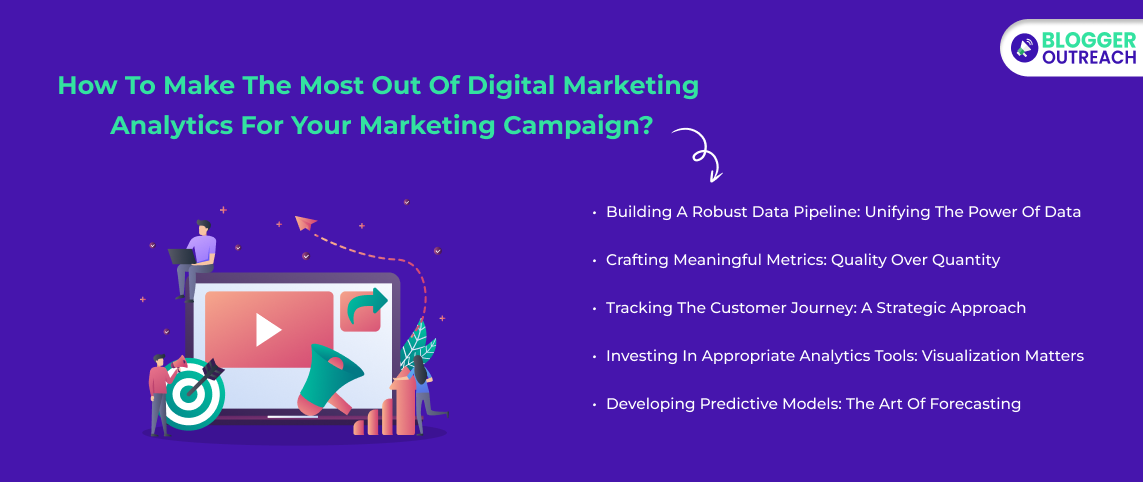
Digital marketing analytics not only steer your campaigns but skyrocket your marketing return on investment (ROI). Here is how…
1. Building A Robust Data Pipeline: Unifying The Power Of Data
You need a robust data pipeline before you can harness the full potential of digital marketing analytics.
Data from various sources is consolidated into a unified view of the customer. Your digital marketing strategy should be based on it.
Collecting data responsibly is crucial. Ensure user consent and prioritize solutions that align with privacy expectations and regulations.
2. Crafting Meaningful Metrics: Quality Over Quantity
While the temptation to track every metric is strong, focus on creating meaningful metrics tailored to your specific use cases.
Start small and expand purposefully. Define your goals and measure results for the most valuable use cases.
Make your marketing more effective by segmenting your customers based on their demographics and behaviour. You can, for example, refine customer segmentation by analyzing marketing campaign data.
3. Tracking The Customer Journey: A Strategic Approach
Digital marketing analytics isn’t a one-size-fits-all solution. Tailoring your approach to different stages of the customer journey is paramount.
Product Awareness Stage
- Metrics: Reach, frequency, engagement.
- Example: Analyzing social media engagements and mentions helps fine-tune marketing strategies for increased awareness.
Consideration/Conversion Stage
- Metrics: Sales, sign-ups, action goals.
- Example: Monitoring bounce rates and conversion rates helps optimize website design for better user experience and increased conversions.
Retention Stage
- Metrics: Click-through rate, customer churn rate, customer lifetime value.
- Example: Using data to determine the right time for customer loyalty programs enhances retention.
4. Investing In Appropriate Analytics Tools: Visualization Matters
Choosing the right analytics tools is like selecting the right lens for a camera. It impacts how you perceive and interpret data.
Opt for tools that allow customization of visualizations, enabling accurate interpretation and communication of marketing’s value.
Many visualizations, such as bar charts, pie charts, tables, and line graphs, are available in today’s landscape. Choose wisely to convey insights effectively.
5. Developing Predictive Models: The Art Of Forecasting
A key lesson from Agile methodology is continuous improvement through rapid test-and-learn cycles.
Understand the performance of your ad campaigns on different channels to allocate your budget effectively.
Combine analytics and prediction to build models that anticipate future trends based on customer segments.
From personal preferences to regional differences, predictive models enhance a company’s ability to forecast, bridging the gap between analysis and action.
It is not enough to analyze the past in the dynamic world of digital marketing.
Making strategic decisions based on future trends ensures your marketing campaigns remain at the forefront of innovation.
Conclusion
Digital marketing strategies will work effectively only when you plan and strategize after you have data or analytics at your disposal.
Without it, you are merely making assumptions that something will work!
This is the reason why Digital marketing analytics should be something that you need to consider here.
So, select the right analytics for your campaign. And take some time to analyze your strengths and weaknesses.
We expect you will take these insights seriously and work on them. If you have anything to ask, reach out to us.
Read Also:

